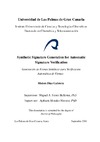Please use this identifier to cite or link to this item:
https://accedacris.ulpgc.es/jspui/handle/10553/19113
| DC Field | Value | Language |
|---|---|---|
| dc.contributor.advisor | Ferrer Ballester, Miguel Ángel | es |
| dc.contributor.advisor | Morales Moreno,Aythami | es |
| dc.contributor.author | Diaz Cabrera, Moises | es |
| dc.date.accessioned | 2016-11-14T13:15:59Z | - |
| dc.date.accessioned | 2018-06-06T08:18:43Z | - |
| dc.date.available | 2016-11-14T13:15:59Z | - |
| dc.date.available | 2018-06-06T08:18:43Z | - |
| dc.date.issued | 2016 | en_US |
| dc.identifier.citation | Mención Internacional | en_US |
| dc.identifier.uri | https://accedacris.ulpgc.es/handle/10553/19113 | - |
| dc.description | Programa de doctorado: Cibernética y Telecomunicación | en_US |
| dc.description.abstract | As a bridge between synthesis of biometric data and human modeling, innovative methods are addressed in this dissertation to generate synthetic handwriting signatures following the insights learnt from the motor equivalence theory. As such, in this Thesis several procedures are proposed to generate i) fully synthetic signature databases and ii) duplicated signatures from a single real specimen. The goal of the proposed methods is to verify whether the generated signatures are able to introduce realistic intra and inter-personal variability in signature-based biometric systems as well as to certify their human-like appearance. For these purposes, machine-oriented and human-oriented evaluations are discussed in the frameworks used in this document. | en_US |
| dc.description.abstract | Learning to write is complex and usually starts with lines and scribbles. Before reaching a mature handwriting, children start to know the letters’ shapes and their sequence, although the children’s motor control is not yet accurate. Modeling this behavior in a mathematically way would allow to understand the mechanical processes from the initial thought of signing to its complete fulfillment. | en_US |
| dc.format | application/pdf | - |
| dc.language | eng | en_US |
| dc.rights | by-nc-nd | - |
| dc.subject | 33 Ciencias tecnológicas | en_US |
| dc.subject | 3304 Tecnología de los ordenadores | en_US |
| dc.subject.other | Firma manuscrita | es |
| dc.subject.other | Verificación | es |
| dc.title | Synthetic signature generation for automatic signature verification | es |
| dc.title.alternative | Generación de firmas sintéticas para verificación automática de firmas | en_US |
| dc.type | info:eu-repo/semantics/doctoralThesis | en_US |
| dc.type | Thesis | en_US |
| dc.compliance.driver | 1 | - |
| dc.contributor.centro | IU de Ciencias y Tecnologías Cibernéticas | en_US |
| dc.identifier.absysnet | 729003 | - |
| dc.investigacion | Ingeniería y Arquitectura | en_US |
| dc.project.acronym | BioSintesis | - |
| dc.project.classification | Investigación | - |
| dc.project.end | 2015-12-31 | - |
| dc.project.reference | TEC2012-38630-C04-02 | - |
| dc.project.scope | Estatal | - |
| dc.project.sponsorship | Ministerio de Economía y Competitividad | - |
| dc.project.start | 2013-01-01 | - |
| dc.project.title | Síntesis de muestras biométricas para aplicaciones de salud y seguridad | - |
| dc.project.type | Proyecto | - |
| dc.rights.accessrights | info:eu-repo/semantics/openAccess | - |
| dc.type2 | Tesis doctoral | en_US |
| dc.utils.revision | Sí | en_US |
| dc.identifier.matricula | TESIS-1241465 | es |
| dc.identifier.ulpgc | Sí | en_US |
| dc.contributor.programa | Programa Oficial de Doctorado en Cibernética y Telecomunicación | es |
| item.grantfulltext | open | - |
| item.fulltext | Con texto completo | - |
| crisitem.advisor.dept | GIR IDeTIC: División de Procesado Digital de Señales | - |
| crisitem.advisor.dept | IU para el Desarrollo Tecnológico y la Innovación | - |
| crisitem.advisor.dept | Departamento de Señales y Comunicaciones | - |
| crisitem.author.dept | GIR IDeTIC: División de Procesado Digital de Señales | - |
| crisitem.author.dept | IU para el Desarrollo Tecnológico y la Innovación | - |
| crisitem.author.dept | Departamento de Física | - |
| crisitem.author.orcid | 0000-0003-3878-3867 | - |
| crisitem.author.parentorg | IU para el Desarrollo Tecnológico y la Innovación | - |
| crisitem.author.fullName | Díaz Cabrera, Moisés | - |
| Appears in Collections: | Tesis doctoral | |
Page view(s)
172
checked on Oct 12, 2024
Download(s)
465
checked on Oct 12, 2024
Google ScholarTM
Check
Share
Export metadata
This item is licensed under a Creative Commons License


